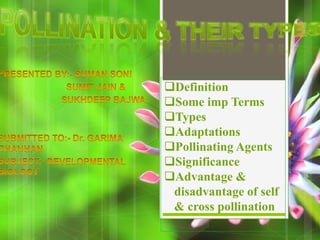
Developmental.ppt
- 1. Definition Some imp Terms Types Adaptations Pollinating Agents Significance Advantage & disadvantage of self & cross pollination
- 2. SOME IMPORTANAT TERMINOLOGY 1. MONOCIOUS PLANTS:-When a flower contains both stamens and pistils, the flower is said to be perfect. The plant which contains perfect flowers is known as a monoecious plant because it has both male and female reproductive organs in the same plant 2. DIOCIOUS PLANTS:-When a plant bears either staminate flowers or pistillate flowers, the plant is known as a dioecious plant. You can find only one type of flowers from a dioecious plant. Male and female reproductive organs are located in separate plants.
- 3. DEFINITION Pollination is defined as the process transfer of pollen grains from anther to the stigma of the same flower or of different flower of the same species.
- 4. TYPES OF POLLINATION 1. AUTOGAMY OR SLF POLLINATION: If pollen grain are transferred from an anther to the stigma of same flower then it is called self pollination or autogamy.
- 5. 2. GEITONOGAMY: When, pollination takes place in between the two flowers of the same plant then it is called geitonogamy GEITONOGAMY
- 6. 3. XENOGAMY OR CROSS POLLINATION When the pollination takes place in between the two different flowers of two different plants of the same species then it is called xenogamy. This is the only type of pollination which brings genetically different types of pollen grains to the stigma during pollination, e.g., papaya, maize, etc.
- 7. CONTRIVENCE OR ADAPTAION FOR SELF POLLINATION 1. MONOCLINY (Bisexuality):- It means flowers are bisexual 2. Homogamy:- when both the sex organs of flower mature at the same time. Ex mirabilis 3. Cleistogamy :-In some plants, flowers never open up and the anthers dehisce inside these closed flowers to ensure pollination. Thus, cleistogamous flowers are invariably autogamous as there is no chance of cross-pollination. These flowers produce assured seed sets even in the absence of pollinators, e.g., Oxalis
- 8. Adaptations for cross pollination 1. Dicliny(Unisexuality):-presence of unisexual flower. 2. Dichogamy :-stamens and carpels of flower do not mature at same time • Protandry :-Anther of flower mature earlier than carpel. ex salvia & sun flower • Protogyny:-the carpel of flower mature earlier than stamens. 3. Chasmogamy or anthesis:-opening of floral bud in the form of a flower.
- 9. Herkogamy:- In some plants morphological barriers are formed in between the anther and stigma of the same flower so self pollination can not occurs and pollen grains from the anthers are unable to reach the stigma of the same flower . Ex Gloriosa Heterostyly:- There is difference in between the length of the filaments of stamens and length of style in flowers of some plants. Ex primrose Self incompatibility :- when a pollen grain produced in a plant reaches a stigma of the same plant or another plant with a similar genotype, the process of pollen germination, pollen-tube growth, ovule fertilization and embryo development is halted at one of its stages and consequently no seeds are produced.
- 10. AGENTS OF POLLINATION ABIOTIC AGENTS BIOTIC AGENTS Mammals Reptiles Birds insects Water pollination or Hydrophily Wind pollination or Anemophily
- 11. Pollination is a vital process of nature. It is estimated that ¾ of our staple crops, and 1/3 of all food crops require pollination. For the fruit seeds to develop, pollen has to be transferred between two flowers of the same species, which then fertilizes the flower and allows the production of healthy seeds on the plant. Pollinators play an essential role in pollination as they work as medium for pollination to be occur. he most widely known pollinators are honey bees. Honey bees are responsible for the pollination and thus production of $19 billion worth of food crops each year, just in the United States alone! There are many other pollinators that are just as vital to food crop productions and plant reproduction as honey bees, but aren’t as well known such as wasps, moths, flies, butterflies, beetles, bats, birds, and ants.
- 12. ADVANTAGE OF SELF POLLINATION 1. Since pollen grains are easily available, pollination rarely fails. It is a sure method of pollination. 2. Flowers do not have to depend on external agencies like wind, water and animals. 3. Minimum wastage of pollen. Thus, a more economical method. 4. Pure line progeny can be obtained. 5. There is no wastage of energy for decoration of flowers to attract insects. 6. There is no chance to obtain unwanted characters.
- 13. 1. Progeny shows less vigor due to continued self pollination. 2. No possibility of introduction of new desirable characters 3. Undesirable characters cannot be eliminated. 4. It does not help in evolution. 5. Disease resistant capacity becomes less.
- 14. 1. The offspring are healthier. 2. The seeds are produced in larger number and are more viable. 3. The seeds develop and germinate properly and grow into better plants. 4. Results in new varieties because cross-pollination can be carried out between two different varieties of the same species or even two species.
- 15. 1. It is not always certain as a pollinating agent is always required, and it may or may not be available at the suitable time. 2. Pollen grains have to be produced in abundance to ensure chances of pollination. This results in lot of wastage of pollen. 3. It is uneconomical for plants as they have to produce flowers that are large, perfumed and with nectar to attract insects.